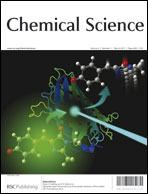A highly selective turn-on fluorescent probe for iron(ii) to visualize labile iron in living cells†
Abstract
Although labile iron plays critical roles in diverse biological processes in living cells, the physiological and pathophysiological functions of iron have not been sufficiently explored, partially due to a lack of methods for visualizing intracellular labile iron. In this edge article, we present a novel turn-on


 Please wait while we load your content...
Please wait while we load your content...